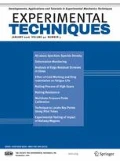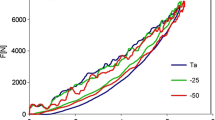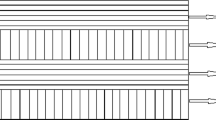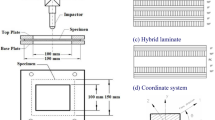Abstract
Over the years, a large number of studies have been carried out on glass fiber composite materials in order to analyze their impact behavior. This is very important for the automotive applications, for example for bumper or crash-box. This paper presents the analysis performed on GFRP (Glass Fiber Reinforced Polymer) laminated plate specimens (epoxy matrix reinforced with E-glass, twill woven, 200 g/m2) subjected to drop impact tests. The tests have been conducted at two different impact speeds in Low Impact Velocity LVI maintaining the same impact energy to estimate the strain-rate effect. All the tests were performed referring to ASTM 7136 at standard ambient temperature. Then the SEA (Specific Energy Absorption) of the specimens was calculated, using three different non-destructive measurement techniques (Optical Analysis, IRThermography and X-ray Computed) to analyze the surfaces of rupture and the specimen interlaminar damages. The chosen geometry of the specimens allowed to reduce the costs and to use a simplest test bench giving additional information to the material behavior.













Similar content being viewed by others
Notes
Non-Destructive Evaluations
References
Carello M, Messana A (2015) IDRA pegasus: a fuel-cell prototype for 3000 km/L. Comput-Aided Des Appl 12(sup1):56–66
Airale A, Carello M, Scattina A (2011) Carbon fiber monocoque for a hydrogen prototype for low consumption challenge. Mater Werkst 42(5):386–392, mag
Carello M, Airale A, Ferraris A, Messana A (2014) XAM 2.0: from student competition to professional challenge. Comput-Aided Des Appl 11(sup1):61–67
Carello M, Airale AG, Ferraris A, Messana A, Sisca L (2017) Static design and finite element analysis of innovative CFRP transverse leaf spring. Appl Compos Mater. https://doi.org/10.1007/s10443-017-9596-6
Carello M, Airale AG (2014) Composite suspension arm optimization for the city vehicle XAM 2.0. In: Öchsner A, Altenbach H (eds) Design and computation of modern engineering materials, vol 54. Springer International Publishing, di Cham, pp 257–272
Carello M, Airale AG, Ferraris A (2014) City vehicle XAM 2.0: design and optimization of the composite suspension system. https://doi.org/10.4271/2014-01-1050
Xu S, Ferraris A, Airale AG, Carello M (2017) Elasto-kinematics design of an innovative composite material suspension system. Mech Sci 8(1):11–22, feb
Belingardi G, Vadori R (2002) Low velocity impact tests of laminate glass-fiber-epoxy matrix composite material plates. Int J Impact Eng 27(2):213–229
Jacob GC, Fellers JF, Simunovic S, Starbuck JM (2002) Energy absorption in polymer composites for automotive crashworthiness. J Compos Mater 36(7):813–850, apr.
Kilic Y (2008) Impact and energy absorption of laminated and sandwich composites. Massachusetts Institute of Technology. https://dspace.mit.edu/handle/1721.1/44883. Accessed 17 July 2017
Yuanjian T, Isaac DH (2008) Combined impact and fatigue of glass fiber reinforced composites. Compos Part B 39(3):505–512, apr.
de Vasconcellos DS et al (2014) Influence of low velocity impact on fatigue behaviour of woven hemp fibre reinforced epoxy composites. Compos Part B 66:46–57, nov.
Quaresimin M, Ricotta M (2005) «Assorbimento energetico durante impatto in laminati in materiale composito», presentato al Associazione Italiana per l’Analisi delle Sollecitazioni-XXXIV Convegno Nazionale, Milano
Meola C, Carlomagno GM, Ricci F, Lo Presto V, Caprino G (2009) Analisi del comportamento all’impatto di compositi con termografia all’infrarosso. presentato al 13° Congreso Associazione Italiana Prove non Distruttive, Roma
(2013)Application of thermography and acoustic emission to detect impact damage in CFRP. presentato al 3° International Conference of Engineering Against Failure, Kos (Greece)
Boritu A, Anghel V, Constantin N, Gavan M, Pascu A (2011) Non-destructive inspection of composite structures using active IR-thermography methods. Sci Bull 73(Serie D)
Meola C, Boccardi S, Boffa N, Maio L, Carlomagno GM (2014) Impact damage of carbon Fiber-reinforced composites: a comparison between infrared thermography and Ultrasonics. presentato al 11° European Conference on Non-Destructive Testing, Prague
Santulli C (2003) Impact damage characterisation of thermoplastic matrix composites using transmission transient thermography. Nondestruct Test Eval 19(3):79–90
Vergani L, Colombo C (2012) Thermographic evaluation of impact damage. presentato al 15th International Conference on Experimental Mechanics, Porto,
Tan KT, Watanabe N, Iwahori Y (2011) X-ray radiography and micro-computed tomography examination of damage characteristics in stitched composites subjected to impact loading. Compos Part B 42(4):874–884, giu
Alemi-Ardakani M et al (2013) Microtomographic analysis of impact damage in FRP composite laminates: a comparative study. Adv Mater Sci Eng 2013:1–10
Leonard F (2014) An innovative use of X-ray computed tomography in composite impact damage characterisation. Presentato al ECCM-16 European Conference on Composite Materials, Seville
Crupi V, Epasto G, Guglielmino E (2016) Internal damage investigation of composites subjected to low-velocity impact. Exp Tech:555–568, apr
Boria S, Obradovic J, Belingardi G (2015) Experimental and numerical investigations of the impact behaviour of composite frontal crash structures. Compos Part B 79:20–27, set
(2015) Standard test method for measuring the damage resistance of a fiber-reinforced polymer matrix composite to a drop-weight impact event. ASTM International, ASTM 7316
Abrate S (1991) Impact on laminated composite materials. Appl Mech Rev 44(4):155
Acknowledgements
The research has been performed by the IEHV (Innovative Electric and Hybrid Vehicles) Group at the Mechanical and Aerospace Engineering Department of the Politecnico di Torino.
We would like to thank the Labormetdue s.r.l. company for the contribution on Tomographic tests.
Author information
Authors and Affiliations
Corresponding author
Rights and permissions
About this article
Cite this article
Virgillito, E., Airale, A.G., Ferraris, A. et al. Specific Energy Absorption Evaluation on GFRP Laminate Plate by Optical, Thermographic and Tomographic Analysis. Exp Tech 43, 15–24 (2019). https://doi.org/10.1007/s40799-018-0257-y
Received:
Accepted:
Published:
Issue Date:
DOI: https://doi.org/10.1007/s40799-018-0257-y




